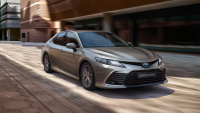Comparing the most popular mass-produced sedans from Germany and Japan
Japanese or German?
If you look at the thematic forums, you are left with the impression of a gigantic conflict tearing the automotive world apart.

But in fact Germany and Japan have more often been allies than enemies. Their car giants have shared different markets and segments and are rarely direct competitors. Volkswagen has been on the verge of a global alliance with Suzuki; Toyota is increasingly cooperating with BMW.
Nevertheless, let's get into the tone of the forum wars for a moment and pit the most popular mass-produced sedans from Germany and Japan against each other.

Rivals
The business sedan segment is melting away year on year, eating up a growing number of SUV models. However, it remains the most prestigious in the mass segment. And the Volkswagen Passat is undoubtedly the protagonist in this, with eight generations from the early 1970s to date and 30 million units sold. For now, the German car has received a long-awaited facelift for 2020.
The Camry is a decade younger and has slightly more modest sales. Last year, the Japanese sedan finally returned to the European market after a long absence, replacing the Avensis.
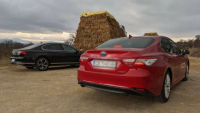
Design
The Passat has always aspired to a more understated design. The current generation is no exception - with its clean lines this car is designed for people who don't like to attract unnecessary attention. The abundance of chrome on the front grille is judged differently, but overall the Passat seems sleek and pleasing to the eye.
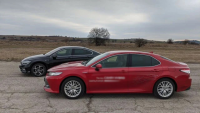
For decades, Toyota has taught us that looks aren't the most important thing, and we're delighted that they've recently abandoned that philosophy. And the Camry doesn't skimp on chrome, but the imposing front bumper harmonises with the rest of the car, the proportions are well-matched and as a result, it's one of the most attractive cars in its segment.
Under the bonnet
Most Passat customers have traditionally looked out for the two-litre turbodiesel, which now has 150 horsepower. There's also a 1.6 TDI with 120 horsepower, there's a supercharged petrol version with 4x4 and 272 horsepower, and a beefed-up diesel with 240 horsepower. At the moment, however, we're testing the most adequate choice in our opinion - a two-litre turbo petrol with 190 horsepower and an automatic double clutch.
With the Camry, the choice is the same as with the Soviet single-party system . In America you can get it with a V6, but in Europe there's only one option - a hybrid drive with an electric motor and a 2.5-litre petrol engine. The total output is 218 horsepower and the gearbox is continuously variable, but not with a belt and cone like the old variators, but with a planetary gearbox and two electric motors. In sport mode, this transmission mimics normal gear shifting and is much nicer than a conventional SVT.
On the road
The Passat steers very cool, though perhaps the Mondeo or Mazda 6 will give you a better feel. The turbocharged engine is pleasantly flexible and the car as a whole feels surprisingly light - nothing that at half a tonne in weight is actually in the same category as the Camry.
Toyota offers firm but not great steering. When necessary, acceleration isn't too bad - 8.3 seconds from 0 to 100km/h. But the supposedly weaker Passat does it almost a second faster. Its torque is half that.
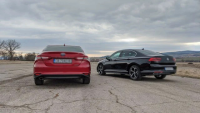
All in all, the Camry encourages you to relax and enjoy its most valuable quality - frugality. The booklet lists a cumulative cost of 4.4 per cent. In stark reality, we've achieved just over 5 per cent, which is really impressive. On the same route, the Passat's petrol showed around 8 per cent.
Both cars drive quite comfortably, though it also depends on the size of wheels you choose.
Practicality
The Camry is slightly longer and has a longer wheelbase, but overall both cars offer plenty of interior space. The seats are comfortable and the boot is 586 litres in the Volkswagen and 524 litres in the Toyota - which fully covers normal family needs.
Materials are of good quality in both models. The German car, however, has a much more modern information system. Neither the Camry's graphics nor the media controls are fully compliant with the third decade of the 21st century. There's also no compatibility with Android Auto and Apple CarPlay. But there is a wireless phone charger and the navigation is more adequate than in the Passat.
On the other hand, the Passat now has USB-C ports, unlike the older Camry. There's also partial gesture control and advanced voice assistant.
Both cars have all modern safety systems, including adaptive cruise control. But the Volkswagen is a little more advanced - it can follow the lane on its own and maintain distance to the car in front at speeds of up to 210 kilometres per hour.
Price
Gone are the days when you could buy a sedan like this for around $20,000 . Now the cheapest Passat with 1.5 turbo and 150 horsepower costs almost $33,000. The more powerful petrol starts at $33,000 and the most refined diesel version with all-wheel drive costs $44,000.
On the lower trim level, the car has aluminum wheels, LED lights, leather steering wheel, automatic lights, tinted windows, parktronic in the front and rear, and a stereo with a 6.5-inch screen.
Additional options include an $800 leather interior. And a 700-watt Dynaudio audio system for $1,700.
The Camry starts at $33,000 on the lowest trim level, which has air conditioning, a radio with a 7-inch screen, automatic lights and wipers, a leather steering wheel and a rearview camera. The fattest kit costs $41,000.
In short, these are two completely comparable offerings. One of them will appeal to people who are delighted with dynamics and modern technologies. The other is for those looking for peace and economy.
But both cars are cheaper and nicer to drive than the SUV models the auto industry is trying to push into the masses.
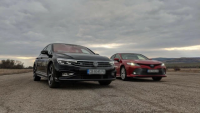

-rear-and-front-view-camera-6.png)
